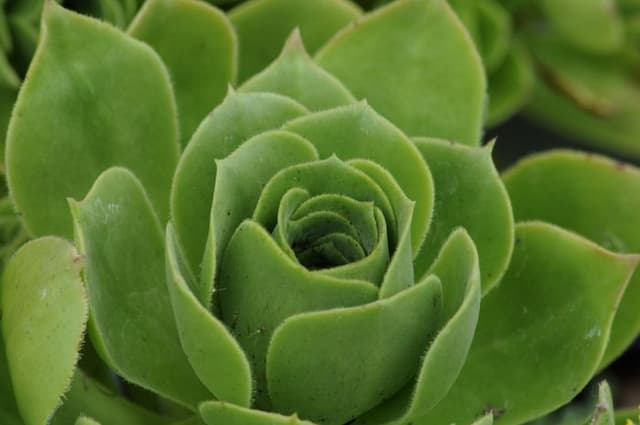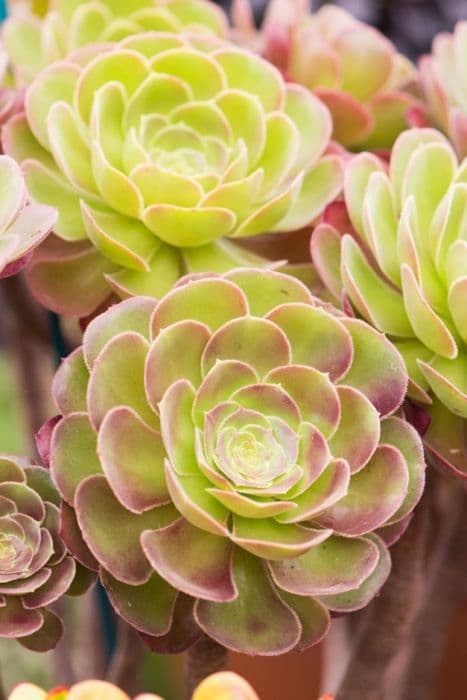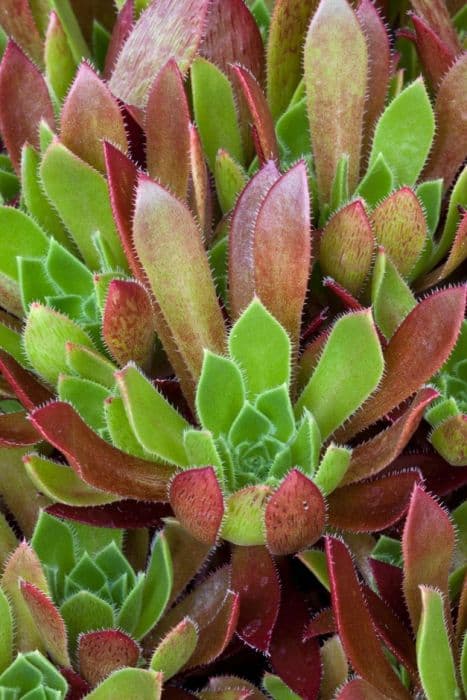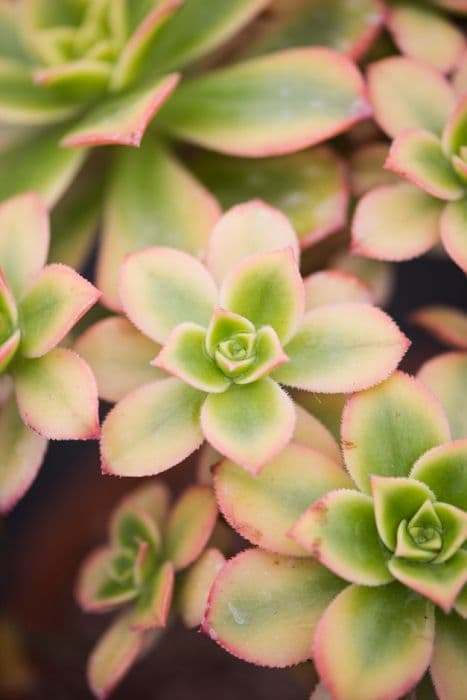Blue Surprise Echeveria Echeveria × gilva 'Blue Surprise'

ABOUT
Echeveria 'Blue Surprise' is a succulent that boasts a rosette-shaped cluster of fleshy leaves. The leaves are a striking blue-green hue with hints of pink or red at the edges, especially when exposed to bright sunlight. The tips of the leaves may also display this pink or red coloration, providing a vibrant contrast to the blue-green backdrop. The leaves are plump and may have a powdery coating, giving them a soft, muted appearance that is characteristic of many Echeverias. The overall impression of the Echeveria 'Blue Surprise' is that of a compact, colorful plant with a symmetrical formation, making it a popular choice for succulent collections and as a decorative houseplant.
About this plant
 Names
NamesFamily
Crassulaceae
Synonyms
Blue Surprise Echeveria, Blue Surprise Hens and Chicks
Common names
Echeveria × gilva 'Blue Surprise'.
 Toxicity
ToxicityTo humans
Echeveria 'Blue Surprise', commonly known as simply Echeveria, is not known to be toxic to humans. Therefore, ingestion of this plant typically does not cause poisoning or toxic symptoms.
To pets
Echeveria 'Blue Surprise', more broadly known as Echeveria, is generally considered non-toxic to pets such as cats and dogs. Ingesting this plant should not cause poisoning or show symptoms typically associated with toxic plants.
 Characteristics
CharacteristicsLife cycle
Perennials
Foliage type
Evergreen
Color of leaves
Blue
Flower color
Pink
Height
0.5 feet (15 cm)
Spread
0.5 feet (15 cm)
Plant type
Succulent
Hardiness zones
9
Native area
Mexico
Benefits
 General Benefits
General Benefits- Decorative Appeal: Adds aesthetic value with its attractive blue-green rosettes and red-tipped leaves.
- Low Maintenance: Requires minimal watering and can thrive in neglect, making it ideal for busy or forgetful gardeners.
- Drought Tolerant: Well-adapted to dry conditions, making it suitable for water-wise gardens and conserving water resources.
- Suitable for Container Gardening: Compact growth habit makes it perfect for growing in pots and small spaces.
- Propagates Easily: Leaves and offsets can be used to propagate new plants, making it easy to expand your collection or share with others.
- Long Lasting: Slow-growing and long-lived, providing many years of enjoyment without needing frequent replacement.
- Non-toxic: Safe to have around pets, creating a pet-friendly environment.
- Attracts Pollinators: When in bloom, it can attract bees and other beneficial insects to your garden.
- Provides Structure in Garden Design: Can be used to create interesting visual compositions due to its sculptural form.
- Adaptable to Different Light Conditions: Can grow in various lighting conditions from full sun to partial shade.
 Medical Properties
Medical PropertiesThis plant is not used for medical purposes.
 Air-purifying Qualities
Air-purifying QualitiesThis plant is not specifically known for air purifying qualities.
 Other Uses
Other Uses- Echeveria 'Blue Surprise' can be used in fairy gardens to create a whimsical, miniature landscape with its rosette shape and pastel colors.
- It can serve as an attractive ground cover in areas where traditional grasses may struggle to grow.
- These plants can be employed in xeriscaping, a landscaping approach that reduces or eliminates the need for supplemental water.
- Due to their compact size, Echeveria 'Blue Surprise' can be used in living walls or vertical gardens as an architectural element.
- Their vibrant color and unique form make them excellent subjects for botanical photography and art projects.
- These succulents can be used as natural decorations on cakes or cupcakes for garden-themed events.
- Echeveria 'Blue Surprise' can be used in corsages or boutonnieres for eco-friendly weddings or proms.
- They can act as natural humidifiers when clumped together in numbers due to the transpiration process.
- For educational purposes, they offer a perfect example of water-wise plants suitable for teaching about drought-tolerant gardening.
- As part of a terrarium, Echeveria 'Blue Surprise' adds a pop of color and interest to enclosed miniature ecosystems.
Interesting Facts
 Feng Shui
Feng ShuiThe Echeveria is not used in Feng Shui practice.
 Zodiac Sign Compitability
Zodiac Sign CompitabilityThe Echeveria is not used in astrology practice.
 Plant Symbolism
Plant Symbolism- Perseverance: Echeverias, as succulents, can thrive in challenging conditions, symbolizing the ability to endure and persist through tough times.
- Self-reliance: Their capacity to store water in their leaves signifies a form of self-sufficiency and the importance of independence.
- Beauty and serenity: Echeverias are often admired for their rosette shape and calming appearance, making them a symbol of peace and tranquility.
- Enduring love: These plants can grow slowly but steadily for many years, which can be seen as a metaphor for lasting relationships that stand the test of time.
- Protection: Some cultures believe succulents like Echeverias ward off negative energy and offer protection to their surroundings.
 Water
WaterThe Echeveria 'Blue Surprise' should be watered deeply yet infrequently, ensuring that the soil is allowed to dry out completely between waterings. Typically, watering once every two weeks should suffice, but this may vary depending on the environmental conditions. When watering, use about 6-8 ounces of water for smaller pots, ensuring that the water is applied directly to the soil and not on the rosette to avoid rot. In the growing season of spring and summer, the watering frequency may increase, while in winter, it's important to reduce it.
 Light
LightEcheveria 'Blue Surprise' thrives best in bright, indirect sunlight. A spot that receives morning sunlight and shade in the afternoon is ideal, avoiding the intense direct sun that might cause leaf scorch. An east or west-facing window is an excellent location for this succulent.
 Temperature
TemperatureEcheveria 'Blue Surprise' prefers temperatures ranging between 60°F and 80°F for optimal growth. It can survive minimum temperatures of around 30°F, but it's crucial to avoid frost. The plant should be kept in a spot where temperatures do not drop below freezing to prevent cold damage.
 Pruning
PruningPruning of Echeveria 'Blue Surprise' is typically only necessary to remove dead or damaged leaves to maintain the plant's appearance and health. It's best to prune in the spring or after flowering. Gently pull away the spent leaves or use sterilized scissors to cut them off. Pruning is not often needed and should be done carefully to avoid damage to the plant's compact rosette.
 Cleaning
CleaningAs needed
 Soil
SoilEcheveria 'Blue Surprise' thrives in a well-draining soil mix composed of one-half succulent mix and one-half perlite or pumice. A pH balance that is slightly acidic to neutral, around 6.0-7.0, is ideal for this succulent.
 Repotting
RepottingEcheveria 'Blue Surprise' should generally be repotted every two to three years to refresh the soil and to give the roots space to grow.
 Humidity & Misting
Humidity & MistingEcheveria 'Blue Surprise' prefers low humidity conditions, typical of its native arid habitats.
 Suitable locations
Suitable locationsIndoor
Place Echeveria 'Blue Surprise' in bright light, away from drafts.
Outdoor
Ensure Echeveria 'Blue Surprise' is in well-drained soil; part sun.
Hardiness zone
9-11 USDA
 Life cycle
Life cycleThe life of an Echeveria 'Blue Surprise', also commonly known as Echeveria, begins with seed germination, where under suitable conditions the seed sprouts to produce a small rosette. As it grows, it enters a vegetative state, characterized by the expansion of succulent leaves in a rosette form, which is key in photosynthesis and water storage. The plant matures and reaches its full size within a few years, depending on the growing conditions. Once mature, the Echeveria 'Blue Surprise' enters its reproductive phase, producing colorful flower stalks that attract pollinators, leading to the production of seeds after flowering. After seed dispersal, the parent plant continues its growth and may also reproduce vegetatively through offsets, or "pups", that form at the base of the plant. Echeverias are long-lived perennials and will continue this life cycle, with individual plants sometimes living for many years under the right conditions.
 Propogation
PropogationPropogation time
Spring-Summer
Echeveria 'Blue Surprise', a striking succulent, can be propagated most effectively through leaf cuttings. The best time to begin this process is during the warmer months, when the plant is actively growing, typically from spring to early summer. To propagate, a healthy, plump leaf is gently twisted off the stem, ensuring that it comes away with a clean snap and no part of the leaf remains on the stem. This is critical for the successful healing and subsequent rooting of the leaf. The leaf is then laid on well-draining soil and left to form a callus for a few days, away from direct sunlight. Once the callus forms, usually taking about 3-5 days, the leaf is placed on top of the soil, where it will eventually send out roots and form a new rosette at the base. Regular misting with water is recommended to maintain slight soil moisture, but overwatering should be avoided to prevent rot.









